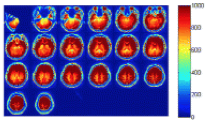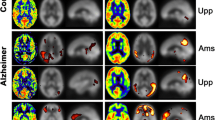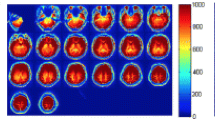Abstract
Arterial Spin Labeling (ASL) is an emerging magnetic resonance imaging technique attracting increasing attention in dementia diagnosis only beginning from recent years. ASL is capable to provide direct and quantitative measurement of cerebral blood flow (CBF) of scanned patients, so that brain atrophy of demented patients could be revealed by measured low CBF within certain brain regions through ASL. However, partial volume effects (PVE) mainly caused by signal cross-contamination due to pixel heterogeneity and limited spatial resolution of ASL, often prevents CBF from being precisely measured. Inaccurate CBF is prone to mislead and even deteriorate dementia disease diagnosis results, thereafter. In this paper, a novel dementia disease diagnosis strategy based on ASL is proposed for the first time. The diagnosis strategy is composed of two steps: 1) to conduct pixel-wise PVE correction on original ASL images and 2) to predict dementia disease severities based on corrected ASL images via ranking. Extensive experiments and comprehensive statistical analysis are carried out to demonstrate the superiority of the new strategy with comparison to several existing ones. Promising results are reported from the statistical point of view.








Similar content being viewed by others
References
Asllani I, Borogovac A, Brown T (2008) Regression algorithm correcting for partial volume effects in arterial spin labeling MRI. Magn Reson Med 60:1362–1371
Brant-Zawadzki M, Gillan G, Nitz W (1992) MPRAGE: a three-dimensional, t1-weighted, qradient-echo sequence–initial experience in the brain. Radiology 182(3):769–775
Brookmeyer R, Johnson E, Ziegler-Graham K, Arrighi M (2007) Forecasting the global burden of alzheimer’s disease. Alzheimers Dement 3(3):186–191
Chen Y, Wolk D, Reddin J, Korczykowski M, Martinez P, Musiek E, Newberg A, Julin P, Arnold S, Greenberg J, Detre J (2011) Voxel-level comparison of arterial spin-labeling perfusion mri and fdg-pet in alzheimer disease. Neurology 77(2):1977–1985
Du Y, Tsui B, Frey E (2005) Partial volume effect compensation for quantitative brain spect imaging. IEEE Trans Med Imaging 24(8):969–976
Erlandsson K, Buvat I, Pretorius H, Thomas B, Hutton B (2012) A review of partial volume correction techniques for emission tomography and their applications in neurology, cardiology and oncology. Phys Med Biol 57(21):119–159
FMRIB Software Library (FSL) toolbox. http://fsl.fmrib.ox.ac.uk/fsl/fslwiki/
Folstein M, Folstein S, McHung P (1975) Mini-mental state: a practical method for grading the cognitive state of patients for the clinician. J Psychiatr Res 12(3):189–198
Galton C, Patterson K, Graham K, Lambon-Ralph M, Williams G, Antoun N, Sahakian B, Hodges J (2001) Differing patterns of temporal atrophy in alzheimer’s disease and semantic dementia. Neurology 57(2):216–225
Golay X, Hendrikse J, Lim T (2004) Perfusion imaging using arterial spin labeling. Top Magn Reson Imaging: TMRI 15(1):10–27
Gold G, Eniko K, Herrmann F, Canuto A, Hof P, Jean-Pierre M, Constantin B, Giannakopoulos P (2005) Cognitive consequences of thalamic, basal ganglia, and deep white matter lacunes in brain aging and dementia. Stroke 36(6):1184–1188
Goldstein T, Osher S (2008) The Split Bregman Method for L1 Regularized Problems. UCLA CAM report 08–29:1–21
Gunn R, Gunn S, Turkheimer F, Aston J, Cunningham V (2002) Positron emission tomography compartmental models: a basis pursuit strategy for kinetic modeling. J Cereb Blood Flow Metab 22:1425–1439
Individual Brain Atlases using Statistical Parametric Mapping (IBA-SPM) Software. http://www.thomaskoenig.ch/Lester/ibaspm.htm
Jarvelin K, Kekalainen J (2000) IR Evaluation Methods for Retrieving Highly Relevant Documents. In: Proceedings ACM Special Interest Group Inf Retrieval (SIGIR), pp. 41–48
Joachims T SVM light - An Implementation of Support Vector Machine in C. URL http://svmlight.joachims.org
Johnson N, Jahng G, Weiner M, Miller B, Chui H, Jagust W, Gorno-Tempini M, Schuff N (2005) Pattern of cerebral hypoperfusion in alzheimer disease and mild cognitive impairment measured with arterial spin-labeling mr imaging: initial experience. Radiology 234:851–859
Keerthi S (2002) Efficient Tuning of SVM Hyperparameters using Radius/Margin Bound and Iterative Algorithms. IEEE Trans Neural Netw 13(5):1225–1229
Laakso M, Partanen K, Riekkinen P, Lehtovirta M, Helkala E, Hallikainen M, Hanninen T, Vainio P, Soininen H (1996) Hippocampal volumes in alzheimer’s disease, parkinson’s disease with and without dementia, and in vascular dementia an mri study. Neurology 46(3):678–681
Liu M, Zhang D, Shen D (2012) Ensemble sparse classification of alzheimers disease. NeuroImage 60(2):1106–1116
Mahendra B (1987) A pathography of dementia. Dementia 1:189–202
Malpass K, Disease Alzheimer (2012) Arterial Spin-Labeled MRI for Diagnosis and Monitoring of AD. Nat Rev Neurol 8(3):847–849
Mioshi E, Dawson K, Mitchell J, Arnold R, Hodges J (2006) The addenbrooke’s cognitive examination revised (ace-r): a brief cognitive test battery for dementia screening. Int J Geriatr Psychiatr 21(11):1078–1085
Murphy K, Brunberg J, Cohan R (1996) Adverse reactions to gadolinium contrast media: a review of 36 cases. Am J Roentgenol 167(4):847–849
Musiek E, Chen Y, Korczykowski M, Saboury B, Martinez P, Reddin J, Alavi A, Kimberg D, Wolk D, Julin P, Newberg A, Arnold S, Detre J (2012) Direct comparison of fluorodeoxyglucose positron emission tomography and arterial spin labeling magnetic resonance imaging in alzheimer’s disease. Alzheimers Dement 8(1):51–59
Parkes L, Rashid W, Chard D, Tofts P (2004) Normal cerebral perfusion measurements using arterial spin labeling: reproducibility, stability, and age and gender effects. Magn Reson Med 51:736–743
Partial volume imaging. http://en.wikipedia.org/wiki/Partial_volume_(imaging)
Rice J (2007) Mathematical Statistics and Data Dnalysis, second edition. Duxbury Press
Statistical Parametric Mapping (SPM) toolbox. http://www.fil.ion.ucl.ac.uk/spm/
United Nations, World Population Prospects. http://www.un.org/esa/population/publications/wpp2006/WPP2006_Highlights_rev.pdf
Wang Z, Das S, Xie S, Arnold S, Detre J (2013) Arterial Spin Labeled MRI in Prodromal Alzheimer’s Disease: A Multi-site Study. NeuroImage: Clin 2:630–636
Wee C, Yap P, Shen D (2013) Prediction of alzheimers disease and mild cognitive impairment using cortical morphological patterns. Hum Brain Mapp 34(12):3411–3425
World Health Organization, The Top 10 Causes of Death. http://www.who.int/mediacentre/factsheets/fs310/en/index2.html
Wright M (2004) The interior-point revolution in optimization: history, recent developments, and lasting consequences. Bull Am Math Soc 42(39):1–16
Zhou L, Wang Y, Li Y, Yap P, Shen D (2011) Hierarchical Anatomical Brain Networks for MCI Prediction: Revisiting Volumetric Measures. PLoS Comput Biol 6(7):e21935
Acknowledgments
The authors would like to acknowledge national grants 61403182, 61363046, 61301194 and 61302121 approved by the National Natural Science Foundation of China, grants 20142BBE50023 and 20142BAB217033 approved by the Jiangxi Provincial Department of Science and Technology, as well as the NWPU grant 3102014JSJ0014 for supporting this study.
Author information
Authors and Affiliations
Corresponding authors
Appendix : Derivation of Equation (10)
Appendix : Derivation of Equation (10)
After applying the chain rule, the gradient of C-NDCG(x) with respect to 𝜃 becomes:
where, the first term of (12) is derived as follows:
Furthermore, \(\pi ^{\prime }(x)\) in (13) can be re-written as follows:
Apply the chain rule to the second term of (12) after incorporating results in (14):
Hence, after substituting derivation results of (13) & (15) into (12), it becomes:
which is the same as (10).
Rights and permissions
About this article
Cite this article
Huang, W., Zhang, P. & Shen, M. A novel dementia diagnosis strategy on arterial spin labeling magnetic resonance images via pixel-wise partial volume correction and ranking. Multimed Tools Appl 75, 2067–2090 (2016). https://doi.org/10.1007/s11042-014-2395-2
Received:
Revised:
Accepted:
Published:
Issue Date:
DOI: https://doi.org/10.1007/s11042-014-2395-2




